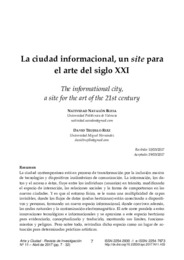Please use this identifier to cite or link to this item:
https://hdl.handle.net/11000/34778Full metadata record
| DC Field | Value | Language |
|---|---|---|
| dc.contributor.author | Trujillo, David | - |
| dc.contributor.author | NATIVIDAD, NAVALÓN | - |
| dc.date.accessioned | 2025-01-17T08:21:21Z | - |
| dc.date.available | 2025-01-17T08:21:21Z | - |
| dc.date.created | 2017-04-01 | - |
| dc.identifier.citation | Arte y ciudad, No 11, págs. 7-32. | es_ES |
| dc.identifier.issn | 2254-2930 | - |
| dc.identifier.uri | https://hdl.handle.net/11000/34778 | - |
| dc.description.abstract | La ciudad contemporánea está en proceso de transformación por la inclusión masiva de tecnologías y dispositivos inalámbricos de comunicación. La información, los da-tos y el acceso a éstos, fluye entre los individuos (usuarios) en tránsito, modificando el espacio de interacción, las relaciones sociales y la forma de comportarnos en las nuevas ciudades. Y es que al entorno físico, se le suma una multiplicidad de capas invisibles, donde los flujos de datos (ondas hertzianas) están conectando a dispositi-vos y personas, formando un nuevo espacio informacional, donde conviven además, las ondas naturales y la contaminación electromagnética. El arte corre paralelo a estas innovaciones tecnológicas e informacionales y se aproxima a este espacio hertziano para evidenciarlo, conceptualizarlo y traducirlo, mostrando sus límites, funciona-mientos y peligros. Pero sobre todo, reivindica dicho espacio como un lugar de ac-tuación para determinadas prácticas artísticas | es_ES |
| dc.description.abstract | The contemporary city is undergoing a process of transformation due to the massive inclusion of wireless communication technologies and devices. Information, data and access to these flow among the individuals (users) in motion, modifying the space of interaction, social relations and the way we behave in new cities. On top of this, a mul-tiplicity of invisible layers, where the data flows (hertzian waves) are connecting devi-ces and people, is being added to the physical environment, thus forming a new infor-mational space, where natural waves and electromagnetic pollution coexist. Art is run-ning parallel to these technological and informational innovations and approaches this Herzian space to evidence it, to conceptualize it and to translate it, showing its limits, functions and dangers. But above all, it reclaims that space as a place of action for cer-tain artistic practices | es_ES |
| dc.format | application/pdf | es_ES |
| dc.format.extent | 26 | es_ES |
| dc.language.iso | spa | es_ES |
| dc.publisher | Universidad Complutense de Madrid | es_ES |
| dc.rights | info:eu-repo/semantics/openAccess | es_ES |
| dc.rights | Attribution-NonCommercial-NoDerivatives 4.0 Internacional | * |
| dc.rights.uri | http://creativecommons.org/licenses/by-nc-nd/4.0/ | * |
| dc.subject | Espacio hertziano | es_ES |
| dc.subject | Arte | es_ES |
| dc.subject | Ciudad | es_ES |
| dc.subject | Comunicación | es_ES |
| dc.subject | Dispositivos inalámbricos | es_ES |
| dc.title | La ciudad informacional, un site para el arte del siglo XXI | es_ES |
| dc.type | info:eu-repo/semantics/article | es_ES |
| dc.relation.publisherversion | https://doi.org/10.22530/ayc.2017.N11.403 | es_ES |

View/Open:
La ciudad informacional, un site para el arte.pdf
1,17 MB
Adobe PDF
Share:
.png)
